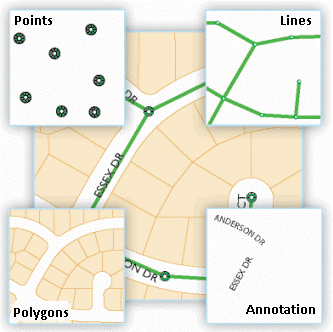A GIS utilizes a layer-based geographic information model for characterizing and describing our world.
ArcGIS
models geographic information as a logical set of layers or themes. For
example, a GIS can contain data layers for the following:
- Streets represented as centerlines
- Land-use areas that represent vegetation, residential areas, business zones, and so forth
- Administrative areas
- Water bodies and rivers
- Parcel polygons representing landownership
- A surface used to represent elevation and terrain
- An aerial photo or satellite image for an area of interest

Geographic information layers such as those described here are represented using a few common GIS data structures:
- Feature classes: Each feature class is a logical collection of features of a common type (such as the four feature types shown here).

- Raster datasets: Rasters are cell-based datasets used to hold imagery, digital elevation models, and other thematic data.

- Attributes and descriptive information: These are traditional tabular information used to describe features and categories about the geographic objects within each dataset.

Like
map layers, GIS datasets are geographically referenced so that they
overlay one another and can be located on the earth's surface.
See Overview of geographic information elements for more information about modeling and representing geographic information.
A GIS uses maps to visualize and work with geographic information.
Each
GIS includes a set of intelligent, interactive maps and other views
(such as 3D globes) that show features and feature relationships on the
earth's surface. Various map views of the underlying geographic
information can be constructed and used as "windows into the geographic
database" to support query, analysis, and editing of geographic
information. Maps can also be used to access geographic modeling tools
that are used to derive new information.

GIS
maps are interactive and help to communicate vast amounts of
information. You can reach "through" an interactive map to present any
set of information that helps your end users meet their missions and do
important work.
See How maps convey geographic information for more information about mapping and visualization.
A GIS has a comprehensive set of analytic and data transformation tools to perform spatial analysis and data processing.
GIS
includes a large set of geoprocessing functions to take information
from existing datasets, apply analytic functions, and write results into
new result datasets. There are numerous spatial operators, such as the
Buffer and Intersect tools shown here, that can be applied to GIS data.

Each
geoprocessing tool takes existing information as input and derives a
new result, which can be used in subsequent operations. This ability to
string together a logical sequence of operations so that you can perform
spatial analysis and automate data processing—all by assembling a
model—is one of the key elements of GIS.
No comments:
Post a Comment